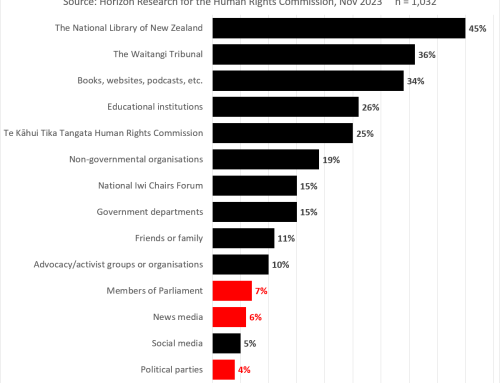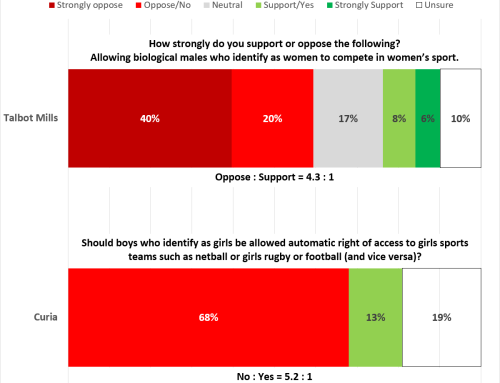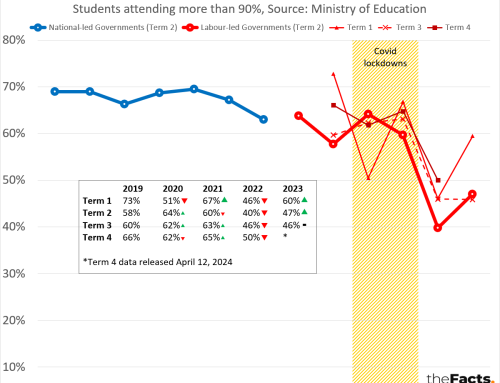KEY INSIGHTS
Of the 2,919,073 party votes cast in the 2020 General Election
- 2,886,420 (99%) were considered valid votes:
- 2,661,238 (92%) went to parties that made it into Parliament
- 225,182 (8%) went to parties that did not make it into Parliament because they did not win an electorate seat or reach the 5% party vote threshold (144,321 votes in 2020). These are often referred to as ‘wasted’ votes.
- The Māori Party made it into Parliament with 33,630 party votes, but three parties polled higher and did not get into Parliament:
- New Zealand First Party = 75,020
- The Opportunities Party (TOP) = 43,449
- New Conservative = 42,613
- 32,653 (1%) were considered invalid votes:
- 21,372 (~2/3) were informal votes and discarded, e.g. a protest message written on the ballot paper.
- 11,281 (~1/3) were disallowed for other reasons, e.g. special votes from someone not on the electoral roll.
- IN TOTAL, 257,835 votes cast did not count towards Parliament seats.
- 2.67 million votes that counted divided by 120 MPs = 22,177 votes (that counted) per seat won. Using this rate, the 257,835 discarded votes equates to 11.6 MP seats. Or, if there was no 5% threshold rule and we divided up all valid votes, then this would be 9.4 MP seats.
KEY QUESTIONS
- Are we ok with this?
- Is vote-to-seat allocation covered sufficiently in our election education material?
- Is the 5% party vote threshold at the optimum level?
- Should we introduce STV (Single Transferable Voting) so that if your first choice doesn’t get in, your second or third choice still counts?
…
HAVE YOUR SAY
…
EXPLANATION
- The term “wasted vote” is commonly used to describe a party vote at a general election which is discarded because the political party did not win a seat in Parliament via either:
- Winning one of the 72 electorate seats (65 General Electorates + 7 Māori Electorates)
- Winning 5% of the overall party vote
- Some argue that it is not a wasted vote, as it still shows support for that party, or a protest vote against other parties.
- Others will cite that those parties still get some taxpayer funding to campaign in the next election, should they wish. See https://www.newshub.co.nz/home/politics/2023/05/how-much-taxpayer-money-electoral-commission-will-give-each-party-for-election-2023-advertising.html.
- On page 62 of https://elections.nz/assets/2020-general-election/Report-of-the-Electoral-Commission-on-the-2020-General-Election-and-referendums.pdf, are the definitions for the other terms:
Informal vote = A vote that cannot be counted as the voter’s preference on the ballot paper is unclear – for example, where the voter leaves the ballot paper blank or puts ticks next to multiple candidates or parties
Disallowed vote = A vote is disallowed if the Returning Officer is satisfied the person’s vote cannot be counted – for example, where the voter is not registered to vote, where a special vote declaration is incomplete or returned late or where it appears a voter has voted more than once at the election
Ordinary vote = A vote cast by a voter who is on an electoral roll at the voting place
Special vote = A vote cast by a voter whose name cannot be marked off an electoral roll at a voting place or who votes somewhere else, for example at home or from overseas and has to complete a declaration that is witnessed (may also be referred to as a ‘special declaration vote’)
- Special voting information from the Electoral Commission:
- Voting from overseas in the 2023 election opens on Wednesday 27 September, and you can vote from overseas in one of the following ways:
- Download your voting papers from the Commission’s website www.vote.nz
- Vote in person at an overseas voting place OVP), e.g. London, Paris, Los Angeles.
- You will be able to complete your voting paper using an electronic device such as a stylus pen or tracking pad. If you are not able to, you will need to print them and complete them by hand. You will be provided with information on how to return them when your voting papers are issued. More information on voting from overseas is available at vote.nz/overseas. This will also be updated by the end of the month with information specific to this year’s general election.
- The counts and explanations for the 10,654 special votes disallowed in the 2020 election are:
- 5,641 = Not enrolled anywhere – if voters aren’t on the New Zealand voting list or can’t be found during special declaration voting, they’re labelled as unenrolled. There are different reasons for this, like thinking they’re already enrolled or believing voting is mandatory even if not enrolled. We won’t reject voters who want to vote, but we might not be sure if they’re enrolled when they vote.
- 2,618 = Not signed by authorised voter
- 998 = Not signed by voter
– despite reminders and messaging, unfortunately people do forget to sign or have their witness sign. This is required by legislation for the vote to be valid. - 437 = Dual votes – means that the voter has voted more than once.
- 388 = No ballot paper enclosed – voters can decide not to vote, but they might do this to get marked off the electoral roll. This could happen because they believe voting is mandatory, even if they don’t want to vote, or they might be expressing that they don’t wish to vote.
- 329 = No grounds stated – on each special declaration form, a voter must choose a reason as to why they are completing a special declaration vote. For voters who are overseas this also requires them to confirm they’re eligible to vote as a citizen or permanent resident and that they have visited NZ within the required timeframes. Again, we encourage voters to check their forms are complete, but this can also be missed.
- 135 = Vote received late – depending on where voters are and how they vote, their ballots might arrive after the legal deadline. If they do, they are marked and processed as received late.
- 102 = Post Writ deletion – some voters might cast votes even though they’re not allowed to due to disqualifying circumstances. These reasons are explained in Section 80 of the Electoral Act 1993.
- 6 = No declaration enclosed – as a person has completed a special declaration vote, their information is provided on a declaration form which is used to check that the voter is qualified / enrolled to vote in the electorate they voted in. If this declaration is missing, we are not able to qualify the voter.
- Voting from overseas in the 2023 election opens on Wednesday 27 September, and you can vote from overseas in one of the following ways:
…
FULL DATA ANALYSIS
Please contact us if you would like the full data set and analysis.
…
OTHER NOTES
- Party colours were based off their logos in the 2020 election.
- We chose a dark blue for the ‘Wasted’ votes segment as that was a good summary colour of the party colours combined which were mostly grey, blues, and greens.
- We adjusted the font sizes relative to the size of each party’s vote count and to fit the space available.
- New Zealand’s electoral system changed from FPP (First Past the Post) in 1993 to MMP (Mixed Member Proportional) in 1996. Under FPP, voters only got one vote for a candidate in their local electorate, so the definition of “wasted votes” is very different, e.g. you might have voted for a party candidate who didn’t win their electorate seat, but their party formed the Government. Or, someone might have won their electorate seat with, say, 40% of the vote so, arguably, 60% of votes were “wasted”. This is why we have focused on MMP election data only where voters can vote for political parties as well.
- In the Electoral Commission’s Report that was released in October 2012, they recommended several changes, including lowering the party vote threshold from 5% to 4%.
- All numbers are provisional and subject to revision.
Thank you to the Factors who helped pull this together.
…
SOURCES:
- Party vote totals = https://www.electionresults.govt.nz/electionresults_2020/statistics/overall-results-summary.html
- Valid and invalid vote totals = https://www.electionresults.govt.nz/electionresults_2020/statistics/party-votes-and-turnout-by-electorate.html
- Definitions = see page 62 on https://elections.nz/assets/2020-general-election/Report-of-the-Electoral-Commission-on-the-2020-General-Election-and-referendums.pdf
- Party logo colours = https://elections.nz/assets/party-register/Register-of-Political-Parties-and-Logos-as-at-9-May-22.pdf
Data published by The Electoral Commission
(c) Crown Copyright
Licensed for use under the creative commons attribution licence (BY) 4.0
…
Did we make a mistake, or have you got smarter data? Let us know.




